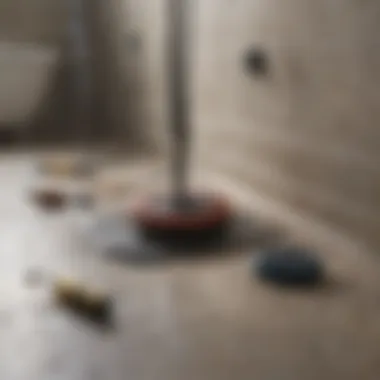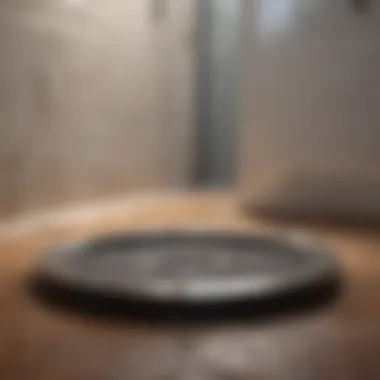Effective Methods for Cleaning a Shower Drain


Intro
A clean shower drain is critical for the overall hygiene of a bathroom. Over time, soap scum, hair, and other debris can accumulate, leading to unpleasant odors and potentially costly plumbing issues. Knowing how to effectively clean a shower drain is more than a routine task; it’s a proactive measure to maintain a functional and sanitary home environment.
In this article, we will explore various methods effective for cleaning a shower drain. Understanding these techniques not only helps in keeping your bathroom clean but also extends the life of your plumbing system. We will look into both preventative measures and specific cleaning solutions to offer readers a comprehensive guide.
By following these steps, readers will discover practical advice that ensures a hassle-free cleaning experience, making shower drain maintenance less daunting and more manageable.
Understanding Shower Drains
The topic of understanding shower drains is crucial in maintaining a functional and efficient bathroom. A shower drain not only serves the purpose of removing water from the shower but also plays a vital role in preventing plumbing issues down the line. A good comprehension of how shower drains work helps homeowners know what to look for when issues arise, promoting quicker and more effective solutions.
A shower drain’s design and placement can significantly affect its performance. Proper drainage ensures that water flows away effectively, reducing the chances of water pooling and potential slip hazards. Understanding these elements enables homeowners to make informed choices about their plumbing systems as well as cleaning methods.
Types of Shower Drains
Shower drains come in various types, each designed for specific purposes and installation scenarios. The most common types include:
- Point drains: Usually located in the center of the shower floor; they require a sloped floor to facilitate water drainage.
- Linear drains: These are long and narrow, often installed along the edge of the shower; they can manage larger volumes of water and provide a modern aesthetic.
- Trench drains: Installed alongside walls, they collect water effectively and are often used in larger shower spaces or wet rooms.
Each type serves a specific function and varies in terms of maintenance needs. Understanding these differences allows for better maintenance practices, which can help prolong the lifespan of the plumbing system.
Common Issues Leading to Clogs
Several factors can lead to clogs in shower drains, some of which can be easily overlooked. Here are the most notable causes:
- Hair accumulation: Hair is the most common source of clogs. When washed down the drain, it tends to bind with soap scum, creating a blockage.
- Soap and shampoo residue: Over time, soap and products can build up in the drain. This residue can combine with other materials, worsening clogs.
- Mineral buildup: Hard water contributes to mineral deposits that can narrow or completely block drain passages.
- Foreign objects: Items like small toys, toiletries, or even jewelry can accidentally fall into the drain.
Being aware of these issues aids in taking proactive measures. A well-maintained shower drain minimizes the likelihood of serious plumbing problems, safeguarding both sanitation and functionality.
The Importance of Regular Maintenance
Regular maintenance of your shower drain is not just a good practice; it is essential for ensuring the longevity and efficiency of your plumbing system. Neglecting this aspect can lead to serious complications which could be costly and inconvenient. By understanding the significance of consistent upkeep, homeowners can avoid common pitfalls that lead to severe issues down the line.
First and foremost, regular maintenance helps in the prevention of clogs. Over time, hair, soap residue, and other debris can accumulate in the drain. This build-up restricts water flow and can culminate in complete obstructions. Therefore, routine checks can significantly minimize the frequency and severity of these clogs.
Moreover, ensuring that your shower drain is clean contributes positively to overall hygiene in your bathroom. A clogged and stagnant drain can become a breeding ground for bacteria and mold. Maintaining a clean shower drain thus is pivotal not only for functionality but for health considerations.
Finally, regular inspection of the drain can reveal potential problems before they escalate. For instance, minor leaks or aging components are often unnoticed until they turn into major repairs. By taking proactive measures, you can save both time and money in the long run.
Preventative Measures
To maintain an efficient shower drain, implementing preventative measures is crucial. Some effective strategies include:
- Regular Cleaning: Simple tasks such as removing hair and debris from drain covers can drastically improve drainage flow.
- Installing Drain Screens: These devices prevent larger items from entering the drains, minimizing the risk of blockages.
- Occasional Flushes with Hot Water: Regularly pouring boiling water down the drain helps dissolve soap scum and grease which can cling to pipes.
Incorporating these measures into your routine can safeguard against larger issues.
Potential Consequences of Neglect
Neglecting the maintenance of your shower drain can lead to significant problems. The consequences are often not immediate but can accumulate over time, leading to bigger headaches:


- Frequent Clogs: Piling up debris can manifest as persistent clogs, requiring more severe cleaning measures.
- Water Damage: If a clog persists, it might lead to water overflowing, causing damage to your bathroom floors and walls.
- Health Risks: Stagnant water caused by clogs can foster unhealthy mold growth, posing health risks to inhabitants.
Regular maintenance is not merely an option; it is a necessity for a functioning and safe bathroom environment.
Tools for Cleaning Shower Drains
Effective shower drain cleaning is not merely dependent on having the right techniques. Equally important is using the appropriate tools, which can make the cleaning process easier and more effective. Knowing which tools to use—and how to use them—can save time, effort, and potential damage to your plumbing. Thus, this section focuses on various tools necessary for maintaining a clean shower drain, considering their characteristics, benefits, and how they contribute to efficient cleaning.
Essential Cleaning Equipment
Plumber's Snake
A plumber's snake, also known as a drain auger, is a flexible tool designed to navigate through the bends of plumbing systems. Its main strength lies in its ability to reach clogs that are deep within pipes. The key characteristic of a plumber's snake is its length and flexibility, enabling it to work effectively in narrow and curved spaces. This is a highly lauded tool in this article because it addresses blockages that often resist simpler methods.
Unique feature: Its coil design is particularly beneficial for breaking apart solid clogs, such as hair and soap scum, without the need for harsh chemicals. However, it can be somewhat tricky to use, especially for those unfamiliar with plumbing tools. Misuse may lead to pipe damage, so caution is advised when attempting.
Drain Cleaner
Drain cleaners provide a chemical approach to tackling clogs. They work by breaking down organic matter that obstructs flow. Their appeal lies in their availability and ease of use. With a simple pour of liquid into the drain, the product does its work, saving time and effort.
The key characteristic of many drain cleaners is their powerful formulation, allowing for the disintegration of buildups within minutes. They are often popular among homeowners because of their fast-acting nature. However, there is a downside. Some cleaner products can be harsh on plumbing over prolonged use, leading to potential damage or degradation of pipes.
Detergents
Detergents are another cleaning tool, typically used as a preventative measure rather than a solution for existing clogs. They can help in maintaining a clean drain by breaking down and suspending grease, soap, and other residues before they accumulate to problematic levels. Their key characteristic lies in their mildness compared to chemical cleaners, making them safer for frequent use.
Detergents are a beneficial choice in this article as they promote long-term hygiene practices within your plumbing system. Unique feature: Many can be made from natural ingredients, appealing to those keen on eco-friendly solutions. However, they may not effectively resolve deeper clogs and should be used as part of a broader maintenance routine.
Safety Equipment
Gloves
Wearing gloves is crucial when cleaning shower drains. Gloves protect your hands from sharp objects or chemical abrasives that may be present. The main characteristic of quality gloves in this context is their durability and resistance to tears. They are vital for a safe cleaning environment and are easily accessible and inexpensive.
The unique feature of gloves is their ability to keep you safe while providing a firm grip. They allow effective maneuvering of tools, such as a plumber’s snake, without compromising safety. While they are generally effective, some people may find traditional rubber gloves less tactile, making it challenging to manage delicate tools.
Protective Eyewear
Protective eyewear serves an equally important function during the cleaning process. When using products that produce fumes or when debris may escape, eyewear can protect against eye damage. The key characteristic of protective eyewear is its form-fitting design, which ensures proper coverage.
In this article, protective eyewear is emphasized due to its role in ensuring a safe cleaning experience. The unique feature is the added layer of security it provides while using chemical cleaners or when working in close quarters. Disadvantages may include discomfort during prolonged use, compelling individuals to ensure proper fit and ventilation.
Step-by-Step Cleaning Process
Cleaning a shower drain is a systematic process that requires attention and methodical execution. Understanding each step ensures not only that the drain is effectively cleaned but also that the risk of future clogs is minimized. By following the detailed steps outlined here, homeowners can maintain their plumbing systems, promote hygiene, and extend the lifespan of their fixtures.
Preparation Before Starting
Before diving into the cleaning process, it is crucial to prepare adequately. This stage sets the tone for effective execution. Gather all necessary tools and materials, which should include gloves, a bucket or container, a plumber's snake, and drain cleaner solutions. Consider wearing protective eyewear to shield against any splashes. Create a workspace that allows ease of movement. This ensures that when the actual cleaning process begins, you are not scrambling around for tools. A well-prepared environment minimizes frustration and enhances efficiency.
Removing the Drain Cover
This step is straightforward yet essential. The drain cover, often secured by screws or clips, must be removed to access the drain. Use a screwdriver for precision if screws are present. If clips are in place, carefully use your fingers or a tool to pry them open. Ensure that you save the cover and any screws in a safe place. Mishandling during this step can lead to further complications, like scratches or damage to the surrounding area. Take this task seriously and handle the cover with care.


Clearing Visible Debris
Once the drain cover is removed, inspect the drain for any visible debris. Hair, soap scum, and other waste often accumulate at the entrance of the drain. Use your gloves to carefully remove this debris by hand. Disposing of this waste in a trash bag instead of rinsing it down the drain helps prevent future clogs. This initial clearing is critical because it gives a clearer view of any deeper blockages that may exist below the surface.
Using a Plumber's Snake
If visible debris removal does not resolve the issue, a plumber's snake becomes necessary. Insert the snake into the drain, carefully pushing it down the pipe. Rotate and push gently until you feel resistance; this indicates a clog. Continue applying a gentle pushing motion to clear it. If the snake retrieves material, dispose of it properly. The plumber's snake is an effective tool for reaching deeper clogs that manual removal could not address. This may require some trial and error, as patience is integral to this step.
Applying Drain Cleaner Solutions
Once you have dealt with the visible and stubborn debris, consider using a commercial drain cleaner. Follow the manufacturer's instructions for application. Pour the solution down the drain, allowing it to sit for the recommended time. This option can help dissolve any leftover gunk or build-up that may still linger. However, always ensure that the chemicals used are suitable for your specific drain type to avoid damaging the plumbing.
Rinsing the Drain
After the designated waiting period has passed, it is time to rinse the drain thoroughly. Run hot water through the drain for several minutes. This helps wash away any remaining residue, ensuring that the plumbing remains clear. Hot water is particularly effective, as it can melt away substances that may cause future clogs. Be diligent in this step; a thorough rinse is just as important as the cleaning itself.
Reattaching the Drain Cover
The final step in the cleaning process is reattaching the drain cover. Make sure the drain is completely dry before doing this. Align the cover correctly and replace any screws or clips securely. Check for stability by gently pressing on the cover. This ensures that everything is in order and ready for use. It may seem like a simple task, but proper reattachment is key to both drainage efficiency and safety.
Effective cleaning of your shower drain not only prevents clogs but also promotes a healthier bathroom environment. Regular maintenance can save you substantial time and money in repairs down the line.
Natural Alternatives for Cleaning
Natural alternatives for cleaning shower drains provide both effective solutions and eco-friendly options. These methods appeal to homeowners who are conscious about the environment and seek to minimize the use of harsh chemicals. Natural ingredients like vinegar and baking soda can clean effectively without producing toxic fumes.
Using natural methods has notable advantages. They are generally safer for both users and plumbing systems. Chemical cleaners often contain harsh substances that can corrode pipes over time. On the other hand, natural solutions not only clean but also neutralize odors.
Furthermore, natural cleaning methods are often more cost-effective than commercial cleaners. Many households already have these ingredients on hand, reducing the need for special trips to the store.
When considering these methods, it is crucial to ensure that they are appropriate for the specific type of clog. While natural solutions can handle many issues, they may not be sufficient for severe blockages.
"Natural cleaning solutions are safe for plumbing and the environment, making them a wise choice for regular maintenance."
Vinegar and Baking Soda Method
The vinegar and baking soda method is a popular choice for cleaning shower drains. This approach leverages the natural acidity of vinegar combined with the mild abrasive properties of baking soda. Together, they create a reaction that helps to dislodge grime and debris.
To implement this method:
- Start with Dry Drain: Ensure the drain is dry before beginning.
- Add Baking Soda: Pour about half a cup of baking soda directly into the drain.
- Add Vinegar: Follow by pouring half a cup of vinegar into the drain. You may see fizzing as they react.
- Cover the Drain: If possible, cover the drain loosely to keep the reaction concentrated. Let it sit for 10-15 minutes.
- Rinse with Hot Water: After the wait, flush the drain with hot water to clear the residues.
This method is particularly effective for light to moderate clogs, and it’s also a preventative measure to help maintain drainage efficiency.
Why Choose Natural Solutions
Choosing natural solutions for cleaning shower drains presents several advantages. First, these methods are generally safe for frequent use. Unlike chemical cleaners, natural alternatives do not pose risks of harming pets or children. They can also prevent damage to plumbing over time.
Another benefit is their simplicity and accessibility. Most households have vinegar and baking soda. This lowers the barrier for use, making it easier for anyone to maintain their plumbing. Additionally, these options can help in maintaining an environmentally friendly home. Many consumers today prefer products that do not harm the planet, and natural solutions cater to that need.
In summary, natural cleaning alternatives offer numerous benefits; they effectively clean without the negative repercussions of conventional cleaners. Being aware of these methods encourages more sustainable cleaning practices in homes.
Dealing with Stubborn Clogs


Dealing with stubborn clogs is an essential part of maintaining a shower drain. These clogs can disrupt the normal flow of water and lead to unsanitary conditions. Frequent and regular cleaning can minimize the risk of these blockages. However, stubborn clogs may still arise despite your efforts.
Understanding the methods to address these clogs will save time and possibly money. Ignoring them can lead to serious plumbing issues, which can be much more costly to fix. Having the right approach to tackle these situations is crucial for every homeowner and can prevent further complications, including potential damage to your plumbing system.
When to Call a Professional
Recognizing when to call a professional plumber is crucial in managing stubborn clogs. If you notice repeated blockages or if the drain does not respond to typical home cleaning methods, it may be time for professional help. Other indicators include:
- Multiple drains affected: If your shower drain isn’t the only one causing issues, it indicates a larger plumbing problem.
- Persistent odors: This can signify that there is a serious blockage or material decay, which may require specialized tools to resolve.
- Water backing up: If water bubbles back from the shower drain or other parts of the plumbing, it can suggest trapped air or deeper obstructions.
- Inability to resolve: If your usual methods fail, calling a plumber ensures proper resolution.
It is better to call a professional than risk further damage.
Advanced Techniques for Heavy Blockages
For those who prefer DIY methods, there are advanced techniques that can be employed for heavy blockages. Some of these methods include:
- Hydro Jetting: Using a high-pressure water jet can dislodge tough blockages within your plumbing.
- Drain Camera Inspection: This helps to locate the problem in the drainage system without invasive procedures.
- Chemical Drain Cleaners: While these should be used with caution, they can break down specific types of clogs effectively.
- Mechanical Tools: Augers or plumber’s snakes are effective for reaching deeper into the pipes where clogs may be stubborn.
While these advanced techniques can be effective, they require a level of skill and safety precautions. In some cases, employing the help of a professional is more efficient, particularly if there is a risk of damaging the plumbing system.
Post-Cleaning Maintenance
Post-cleaning maintenance is a critical component in the overall health of your shower drain. After you have taken the necessary steps to clean your drain, it’s essential to shift your focus towards how to maintain its functionality moving forward. Proper maintenance helps in preventing future clogs and contributes to the longevity of your plumbing system. It also makes cleaning easier during subsequent sessions.
Establishing a Maintenance Routine
Creating a maintenance routine does not have to be complex. A straightforward schedule can suffice. Regular cleaning prevents the accumulation of debris that often leads to blockages. Consider setting a time, perhaps monthly, when you do a thorough inspection and cleaning of your shower drain.
- Monthly Checks: Inspect the drain for visible debris. Clearing hair and soap scum regularly can prolong your efforts.
- Simple Flushes: Pour hot water down the drain weekly. This helps dissolve any small buildups before they become problematic.
- Use Baking Soda and Vinegar: Monthly, you can pour a mixture of baking soda followed by vinegar. This natural solution can aid in maintaining clear pipes.
Signs That Your Drain Needs Attention
Understanding the signs that your drain requires professional help or immediate attention can save you from larger problems down the road. Ignoring these signals can lead to more significant issues such as slow drainage or foul odors. Here are some key indicators to watch for:
- Slow Drainage: If you notice the water pooling in your shower, it’s a clear signal of blockage. This often means there is a buildup requiring prompt action.
- Unpleasant Odors: A smelly shower drain could indicate trapped debris or mold. Such a problem demands immediate attention to avoid health concerns.
- Frequent Clogs: If clogs seem to happen more often than usual, it might indicate a deeper issue with your plumbing.
- Gurgling Noises: Disturbing sounds when water flows can indicate air in the pipes, which may hint at a clog.
Remember, addressing these signs early can save you time, money, and the hassle of dealing with serious plumbing issues.
By establishing a consistent maintenance routine and being alert to the signs that your drain needs attention, you can significantly enhance the performance and lifespan of your shower plumbing.
Epilogue
Effective cleaning of a shower drain serves not only to maintain a hygienic bathroom environment but also to ensure the ongoing functionality of your plumbing system. Regular attention to this often-overlooked area can prevent significant issues, such as unpleasant odors and severe clogs, which might necessitate costly plumbing interventions. By understanding how to maintain your shower drain, you comprehend the clear symbiosis between good practices and their long-term rewards.
Recap of Effective Cleaning Strategies
To recap, regular cleaning of shower drains involves several straightforward yet effective strategies. Implementing a routine maintenance approach:
- Weekly inspections and cleanings can prevent buildup.
- Using natural ingredients like vinegar and baking soda is both effective and environmentally friendly.
- If clogs become stubborn, utilizing tools like a plumber's snake can resolve the majority of blockages.
- Safety should never be overlooked; proper gear like gloves and eyewear is essential during this process.
These methods together create a comprehensive strategy for drain health. They will help maintain proper drainage and prolong the life of your plumbing system.
The Long-Term Benefits of a Clean Drain
Maintaining a clean shower drain has impacts that extend beyond immediate functionality.
- Increased Longevity of Plumbing: Regular cleaning prevents sudden failures and prolongs the life of pipes and fixtures.
- Reduction in Health Risks: Toiletries and organic matter trapped in drains can breed bacteria and unpleasant odors, while diligent cleaning minimizes these risks.
- Cost Efficiency: Addressing minor issues early on saves homeowners from expensive repairs later. Ensuring your shower drain is clean means fewer emergency plumbing situations.
In summary, a commitment to the cleanliness of shower drains is more than an aesthetic concern. It is a proactive approach to home maintenance that encourages longevity, hygiene, and cost-effectiveness. Being informed and taking actionable steps can significantly enhance not only your shower experience but also your overall home environment.















